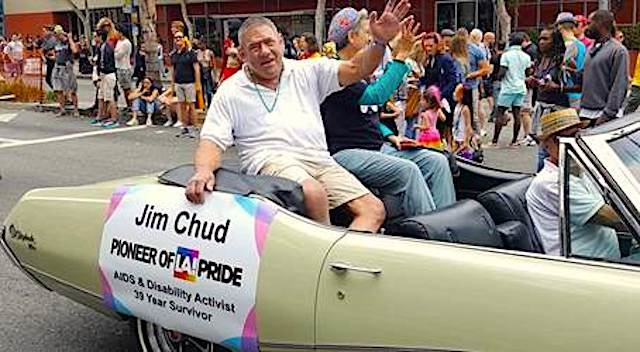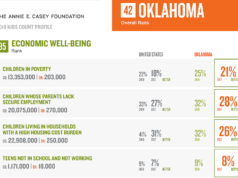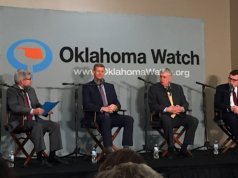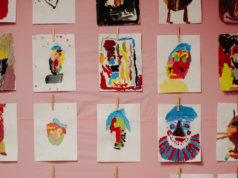
LOS ANGELES — On this World AIDS Day, I will enter my 40th year of living with HIV. I have seen a lot over those years. In the melee of the early and mid-80s, I knew too many men who got sick and died suddenly, usually after the disease boiled most of their lean muscle mass off their frames.
I still have those PTSD moments of being in my friend Jerry’s hospital room and seeing him in a fogged-up oxygen tent, every breath made painful and difficult by pneumocystis pneumonia.
He motioned me to come into the tent so that we could hear each other. Scared, I looked around the room for reassurance that I wasn’t going to hurt him if I did so. A nod from his lover, and I was in the steam, touching his sticky “old person” hand and bawling my eyes out. It was the first time I ever touched someone who I knew was going to die since my dad had died of lung cancer in my late teens. It would not be the last time that happened — not by a long shot.
That was the day AIDS got real for me.
May cause side effects
My best idea back in 1985 of how to keep from wasting away and dying was to take my working out to what I thought would be a life-sparing level. I was determined to put on as much muscle as I possibly could. To make that happen, I took every steroid I could get my hands on. I also used the gym and the drugs — yes, steroids are drugs with mood-altering qualities — to escape the fear and feelings I was having as more people around me kept getting sick and dying.
In 1987, I was living in Washington, D.C. After two senseless double-blind studies at George Washington University, I drove out to the National Institutes of Health with my best friend and volunteered for whatever clinical trial would take me. I was 29 and not expecting to see 35. That seemed like the age when all my friends were getting sick and passing away. I figured that if I somehow hit the jackpot and the drug in my study was the an answer to AIDS, then fantastic. If not, and the drug was useless (which was the more likely result), at least I had done something concrete to help eliminate one of the clunkers. So many of us, HIV-positive or negative, were desperate to do something to help, and this worked for me.
About five weeks into the study, after seeing our formerly full waiting room on study days dwindle, I feared the study would stop. I was rooting for this one to be a success for so many reasons that weren’t about me. I have to admit that, up to that point, I felt invincible, like I was going to live forever. After all, I was the big, healthy muscle guy in the study. This study was for all of those other sick guys, right? Denial served me well, until I experienced the “side effect” that would change my life forever.
‘This isn’t the quality of life we discussed’
One evening, I had taken a good friend who was in a different study at the NIH out for what ended up being his last restaurant meal. When we arrived in the restaurant, all eyes were on us. It hadn’t dawned on either of us that we might look a little scary — everybody we knew had various lines and bandages hanging off them — but the host clearly was concerned about our appearance and placed us in a very private corner of the dining room. We both had a good laugh at that one.
About 10 minutes after our food came, I started dropping my utensils for no apparent reason. In a surprisingly short time I could not open my mouth wide enough to put food in, and I couldn’t do anything but slurp it off my plate. Something was very wrong. I paid the check, and we bee-lined it back to the NIH.
One of the fellows from our study, Rick Rosenberg, was the on-call physician that night. He greeted me with: “Oh, hello Mr. Chud, you know, we are not an emergency room, what seems to be the problem?” I tried to tell him through my clenched teeth. My friend Joe, having had a brain biopsy earlier that day, had been unable to speak clearly enough for Rosenberg to understand him. In retrospect, there was an element of comedy to this whole evening for which I was quite grateful. Humor and irony have long been my favorite tools for dealing with unpleasant times.
Rosenberg’s marching orders were to draw some fluid off my knees, which were more swollen than any of my other joints, and admit me to a ward on the 12th floor. After about 30 minutes of repeatedly failed attempts to drain anything off my knee, I could see that Rosenberg was crying, and I asked him to stop. I will never forget the look of his bloodshot eyes as he dried off his glasses and apologized over and over for having failed and causing me so much pain. Rosenberg’s care was emblematic of how much we all felt that NIH was on our side.
The next morning, Dr. Sam Broder, the head of AIDS research at the NIH’s National Cancer Institute, came into my room with all of the study fellows in tow. After walking around my bed and going, “Hmm,” a few times, he said, “Ya know Jim, if you can just get past this side effect, the virus just hates this drug.”
Through my clenched jaw I replied: “Uh, Sam, this isn’t the quality of life we discussed at the beginning of the study.”
With a forlorn look, he sighed, saying, “I guess you’re right,” and took me off the study.
‘Disposable’ subjects in the path of scientific progress
My symptoms resolved in three or four days. I was told at the time that my immune system had mounted a response to my cartilage, and that my condition was a lot like rheumatoid arthritis. What really surprised me is that, at the time I was taken off study, they didn’t plan on monitoring me going forward. I asked about it and was told that there was no funding for and nothing in the protocol about following people after the participation phase was done.
I remember being really shocked, especially in light of the trajectory that this epidemic was taking and the concern with finding the key to long-term survival by amfAR and others. It became alarmingly clear that we were considered disposable since we would probably die in a few years from AIDS anyway, so no questions would be asked about why we died.
The other sad fact was that being homosexuals made us that much more disposable. Remember, this was in the day of the “Patient Zero” witch hunt when so many Americans wanted to find some “queer that probably had sex with a monkey!” to blame for bringing this epidemic into our country. In the end, that frenzy and waste of time only served to energize the gay-rights community. At least we knew who our enemies were.
Returning to the NIH
From 2003 to 2015, I have been treated to more than 80 operations on my spine, neck and major joints to try to ameliorate the legacy of that fateful NHI clinical trial. I am now seven inches shorter than when I entered the study, because all my disks are gone. There are more than a few people who, upon seeing me for the first time since my bodybuilding days, have no idea who I am until they hear my voice.
In 2009, I had heard from my local HIV doc’ that the head of the study in 1987 was still at the NIH. He had actually taken over the spot formerly held by Dr. Broder. So I decided to call him and ask if NIH would check me out to see if they had any ideas for how to deal with my condition. Upon arrival, I was reminded of just how humane the researchers there really are. I was quite overwhelmed by the whole occasion, especially since I knew that the funds for my visit were coming out of administrative dollars instead of some funded study or drug company.
Since that day, I have thought a lot about the other people in that original NIH study and others. Those people volunteered for the task of saving lives and helping protect our nation from the ravages of the War Against AIDS, much like our country’s soldiers volunteered in military conflicts across the world. I spoke to two other people who were also in the studies. Both of them had their lives completely destroyed by what happened to them. Both of them have since died.
After an exhaustive search of my own, I have found no one else who is still around to talk about their study and consequences they suffered. Maybe this article will tease out some of them.
Parting wishes for World AIDS Day
Back in the days when AIDS was the darling of the fundraising set, some people actually got help. As I have seen the amazing groundswell of support for our veterans returning from Iraq and Afghanistan, which is totally deserved, I do have hope for more humane treatment of AIDS/HIV patients moving forward. I have to admit, though, that I get more than a little sad when I see how the AIDS warriors — the Forgotten Warriors — have been treated. I have had the resources to make a life for myself, but the vast majority of people, at least in my study cohort, were already further along in their disease and left to fade away. That is just wrong.
The reckless abandon of the large pharmaceutical companies and a lack of willingness to take responsibility is what angers me now. Companies that made and continue to make billions of dollars from drugs that eventually passed muster were able to minimize their losses because of men and women who, like myself, volunteered to receive the drugs that failed. Those companies have never once reached out to any of us to offer a simple thank you or to see how we were doing after our trial experiences. In my opinion, this is reprehensible. Now, when long-term survivors really need help, there aren’t any associations available to help us. I can only hope that a more humane, responsible approach will be taken in all future drug studies.
In addition to improvements in the realm of clinical studies, my other wishes for this World AIDS Day are:
- The world realizes that this epidemic is far from over.
- More people volunteer for studies and other opportunities to help.
- That other people like myself speak out and tell their stories if they can.
- That somebody listens and cares.
- That younger people learn about the worst of the epidemic and are taught not to make our mistakes.
- That we all try to understand each other a little better.
(Editor’s Note: This piece is an edited excerpt from the author’s memoir.)





















